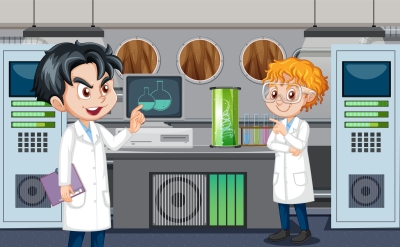The Making of a Scientist- Footprints Without Feet -Chapter 6
Class 10
Chapter 6 of the Class 10 English textbook, "Footprints Without Feet," presents the inspiring story of a young boy named K. Srinivasan who overcomes incredible obstacles to become a successful scientist. In "The Making of a Scientist," readers are taken on a journey through Srinivasan's early life in a small village in Tamil Nadu, India, where he faced poverty, discrimination, and limited access to education. Despite these challenges, Srinivasan's passion for science and determination to succeed led him to pursue his dreams relentlessly. Through his perseverance, hard work, and ingenuity, Srinivasan not only became a successful scientist but also helped to transform the field of organic chemistry in India. In this article, we will examine the themes, literary devices, and historical context that make "The Making of a Scientist" a compelling and inspiring read for students and readers of all ages.
Read and Find Out-The Making of a Scientist- Footprints Without Feet -Chapter 6
(Page 32)
Question 1.
How did a book become a turning point in Richard Ebright’s life?
Answer:
The book ‘The Travels of Monarch X’ opened the world of science for Richard. After reading it he became interested in tracking the migration of butterflies. This interest led to his other projects and experiments. Finally, he became a great scientist. The Making of a Scientist- Footprints Without Feet -Chapter 6
Question 2.
How did his mother help him?
Answer:
Richard’s mother proved to be a great help. She took him on trips and bought scientific equipment for him. She spent all her time in setting up challenges for him. This helped him to learn a lot. She presented him the book ‘The Travels of Monarch X’. The book changes Richard’s life forever.
Page 34 - The Making of a Scientist- Footprints Without Feet -Chapter 6
Question 1.
What lesson does Ebright learn when he does not win anything at a science fair?
Answer:
Ebright exhibited slides of frog tissues at a science fair. He did not get any prize. He learnt an important lesson that science is not just about display. It is about projects and experiments. He began conducting experiments from that day onwards.
Question 2.
What experiments and projects does he do then undertake?
Answer:
He undertook many projects and experiments. He worked on viceroy butterflies to show that they copied monarch butterflies. He studied bright spots on the monarch pupa and discovered a new hormone. Also, he found out how cells read their DNA.
Question 3.
What are the gualities that go into the making of a scientist?
Answer:
There are three essential qualities that make a scientist. The first is a first rate mind. Next is the presence of curiosity. Last but not the least, it is the will to do the best and win.
Think About It
(Page 38)
Question 1.
How can one become a scientist, an economist, a historian … ? Does it simply involve reading many books on the subject? Does it involve observing, thinking and doing experiments?
Answer:
Reading many books on a subject is not enough. One must develop the skill of observation and thinking. Experiments need to be done. One needs to have curiosity to explore and find new things. Above all, one must work hard and not get upset by failures.
Question 2.
You must have read about cells and DNA in your science books. Discuss Richard Ebright’s work in the light of what you have studied. If you get an opportunity to work like Richard Ebright on projects and experiments, which field would you like to work on and why?
Answer:
DNA carry the blue print of life and heredity. They pass information from one generation to the other.
If I get an opportunity to work like Richard Ebright, I would choose to study about diseases. By studying the DNA, I may find ways and means to cure many illnesses.
Talk About It- The Making of a Scientist- Footprints Without Feet -Chapter 6
(Page 38)
Question 1.
Children everywhere wonder about the world around them. The questions they ask are the beginning of scientific inquiry. Given below are some questions that children in India have asked Prof. Yash Pal and Dr. Rahul Pal as reported in their book, Discovered Questions. (published by NCERT in 2006).
- What is DNA fingerprinting? What are its uses?
- How do honeybees identify their own honeycombs?
- Why does rain fall in drops?
Can you answer these questions? You will find Prof. Yash Pal’s and Dr. Rahul’s answers (as given in Discovered Questions) on
Page 75.
Answer:
- DNA fingerprinting is a forensic technique used to identify individuals by the characteristics of their DNA. It is used in parentage testing. It is also used in criminal investigation to identify a person or to place him at the scene of crime.
- Honeybees have signalling chemicals. They leave trails for fellow honeybees so that they can reach their honeycomb.
- The only solid thing in the air are dust particles. Water vapour uses it as a centre of attraction when it becomes too heavy. Water vapor condenses on the dust particle as a drop and falls on Earth. -The Making of a Scientist- Footprints Without Feet -Chapter 6
Question 2.
You also must have wondered about certain things around you. Share these questions with – your class, and try and answer them.
Answer:
Some of the questions are
- Why is the sky blue?
- Why do stars twinkle?
- What is a rainbow?
- Why do fruits fall on Earth?
Download the eSaral App for complete Class 10 Video lectures, Study material, revision and much more.
The Making of a Scientist- Footprints Without Feet -Chapter 6
Click here to get exam-ready with eSaral
For making your preparation journey smoother of JEE, NEET and Class 8 to 10, grab our app now.
